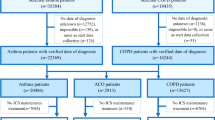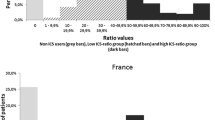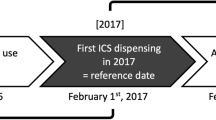Abstract
Objective To determine medication possession ratio (MPR) of patients with asthma/COPD drugs. Method Individual patient’s volumes of asthma/COPD drugs (ATC-code R03) for 2000–2004 were obtained from a pharmacy record database. For each patient the MPR was calculated as the percentage of the treatment time that the patient had drugs available. Main outcome measure Medication possession ratio (MPR). Results A total of 1,812 patients, 20 years and older, with dispensed asthma/COPD drugs were registered in the database, 928 patients (51%) had acquired drugs less than once per year (68% for 20–29 years old) during the 5-year study. Only 13% of the patients had steroids and steroid combinations available to allow continuous treatment. Eight percent of the patients 20–29 years old had MPR ≥ 80% of all the included drugs and 5% when only steroids and steroid combinations were considered. About 25% of the patients had acquired 80% of the total volume of asthma/COPD drugs. Conclusion The majority of the patients, and particularly those in the youngest age group used asthma/COPD drugs only sporadically. This may indicate undermedication which is likely to have a negative impact on patient outcome.

Similar content being viewed by others
References
Adherence to long-term therapies. Evidence for action. WHO-report. WHO, Geneva 2003.
Col N, Fanale JE, Kronholm P. The role of medication noncompliance and adverse drug reactions in hospitalizations of the elderly. Arch Intern Med. 1990;150:841–45.
Haynes RB, Yao X, Degani A, Kriplani S, Garg A, McDonald HP. Interventions for enhancing medication adherence. The Cochrane Database of Systematic Reviews 2005, Issue 4. Art.No.:CD000011.pub2.DOI:10.1002/14651858.CD000011.pub2.
Johnson JA, Bootman JL. Drug-related morbidity and mortality. A cost-of-illness model. Arch Intern Med. 1995;155:1949–56.
Ernst FR, Grizzle AJ. Drug-related morbidity and mortality: Updating the cost-of-illness model. J Am Pharm Assoc 2001;41:192–9.
Steiner JF, Prochazka AV. The assessment of refill compliance using pharmacy records: methods, validity and applications. J Clin Epidemiol. 1997;50:105–16.
Jackevicius CA, Mamdani M, Tu JV. Adherence with statin therapy in elderly patients with and without acute coronary syndromes. JAMA 2002;288:462–7.
Wei L, Wang J, Thompson P, Wong S, Struthers AD, MacDonald TM. Adherence to statin treatment and readmission of patients after myocardial infarction: a six year follow-up study. Heart 2002;88:229–33.
Morningstar BA, Sketris IS, Kephart GC, Sclar DA. Variation in pharmacy prescription refill adherence measures by type of oral antihyperglycaemic drug therapy in seniors in Nova Scotia, Canada. J Clin Pharm Ther. 2002;27:213–20.
Andersson K, Melander A, Svensson C, Lind O, Nilsson JLG. Repeat prescriptions – refill adherence in relation to patient and prescriber characteristics, reimbursement level and type of medication. Eur J Public Health 2005;15:621–6.
Lynd LD, Guh DP, Paré PD, Anis AH. Patterns of inhaled asthma medication use. A 3-year longitudinal analysis of prescription claims data from British Columbia, Canada. Chest 2002;122:1973–81.
Dorais M, Blais L, Chabot I, LeLorier J. Treatment persistence with leucotriene receptor antagonists and inhaled corticosteroids. J Asthma 2005;42:385–93.
Boethius G, Wiman F. Recording of drug prescriptions in the county of Jamtland, Sweden. I. Methodological aspects. Eur J Clin Pharmacol. 1977;12:31–5.
Wessling A. Continuous recording of drug prescribing in Sweden 1974–1983. Methods and examples of utilization of data. Eur J Clin Pharmacol. 1987;33:7–13.
Guidelines for ATC classification and DDD assignment 2006. WHO Collaborating Centre for Drug Statistics Methodology. Oslo, Norway. www.whocc.no.
Sikka R, Xia F, Aubert RE. Estimating medication percistency using administrative claims data. Am J Manag Care 2005;11:449–57.
Haupt D, Nilsson JLG. Defined daily doses (DDD) related to prescribed daily doses (PDD) for asthma/COPD drugs in Sweden. WHO Drug Info. 2006;20:261–4.
Marklund B, Tunsäter A, Bengtsson C. How often is the diagnosis bronchial asthma correct? Fam Pract. 1999;16:112–6.
Nilsson JLG, Johansson H, Wennberg M. Large differences between prescribed and dispensed medicines could indicate undertreatment. Drug Inf J. 1995;29:1243–6.
Nolte H, Nepper-Christenese S, Backer V. Unawareness and undertreatment of asthma and allergic rhinitis in a general population. Respir Med. 2006;100:354–62.
Enright PL, McClelland RL, Newman AB, Gottlieb DJ, Lebowitz MD. Underdiagnosis and undertreatment of asthma in the elderly. Chest 1999;116:603–13.
Peters SP, Ferguson G, Deniz Y, Reisner C. Uncontrolled asthma: a review of the prevalence, disease burden and options for treatment. Respir Med. 2006;100:1139–51.
Lindström M, Jönsson E, Larsson K, Lundbäck B. Underdiagnosing of obstructive lung disease in northern Sweden. Int J Tuberc Lung Dis. 2002;6:78–84.
Lundbäck B, Lindberg A, Lindström M, Rönmark E, Jonsson AC, Jonsson E et al. Not 15 but 50% of smokers develop COPD? Respir Med. 2003;97:115–22.
Takahashi T, Ichinose M, Inoue H, Shirato K, Hattori T, Takishima T. Underdiagnosis and undertreatment of COPD in primary care settings. Respirology 2003;8:504–8.
Acknowledgements
Support from Apoteket AB and the Swedish Association of Senior Citizens (SPF) is gratefully acknowledged.
Financial support
Financial support was obtained from Apoteket AB and the Swedish Association of Senior Citizens (SPF), Stockholm.
Conflict of interest
The authors have no conflict of interest to declare.
Author information
Authors and Affiliations
Corresponding author
Rights and permissions
About this article
Cite this article
Haupt, D., Krigsman, K. & Nilsson, J.L.G. Medication persistence among patients with asthma/COPD drugs. Pharm World Sci 30, 509–514 (2008). https://doi.org/10.1007/s11096-008-9197-4
Received:
Accepted:
Published:
Issue Date:
DOI: https://doi.org/10.1007/s11096-008-9197-4




